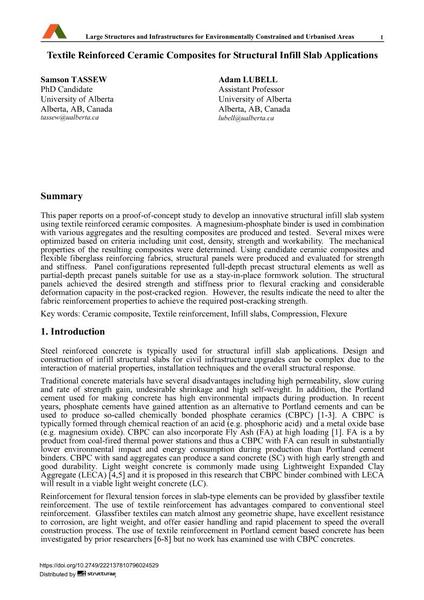Textile Reinforced Ceramic Composites for Structural Infill Slab Applications

|
|
|||||||||||
Bibliografische Angaben
| Autor(en): |
Samson Tassew
Adam Lubell |
||||
|---|---|---|---|---|---|
| Medium: | Tagungsbeitrag | ||||
| Sprache(n): | Englisch | ||||
| Tagung: | IABSE Symposium: Large Structures and Infrastructures for Environmentally Constrained and Urbanised Areas, Venice, Italy, 22-24 September 2010 | ||||
| Veröffentlicht in: | IABSE Symposium Venice 2010 | ||||
|
|||||
| Seite(n): | 268-269 | ||||
| Anzahl der Seiten (im PDF): | 8 | ||||
| Jahr: | 2010 | ||||
| DOI: | 10.2749/222137810796024529 | ||||
| Abstrakt: |
This paper reports on a proof-of-concept study to develop an innovative structural infill slab system using textile reinforced ceramic composites. A magnesium-phosphate binder is used in combination with various aggregates and the resulting composites are produced and tested. Several mixes were optimized based on criteria including unit cost, density, strength and workability. The mechanical properties of the resulting composites were determined. Using candidate ceramic composites and flexible fiberglass reinforcing fabrics, structural panels were produced and evaluated for strength and stiffness. Panel configurations represented full-depth precast structural elements as well as partial-depth precast panels suitable for use as a stay-in-place formwork solution. The structural panels achieved the desired strength and stiffness prior to flexural cracking and considerable deformation capacity in the post-cracked region. However, the results indicate the need to alter the fabric reinforcement properties to achieve the required post-cracking strength. |
||||
| Stichwörter: |
Druck textile Bewehrung
|
||||
